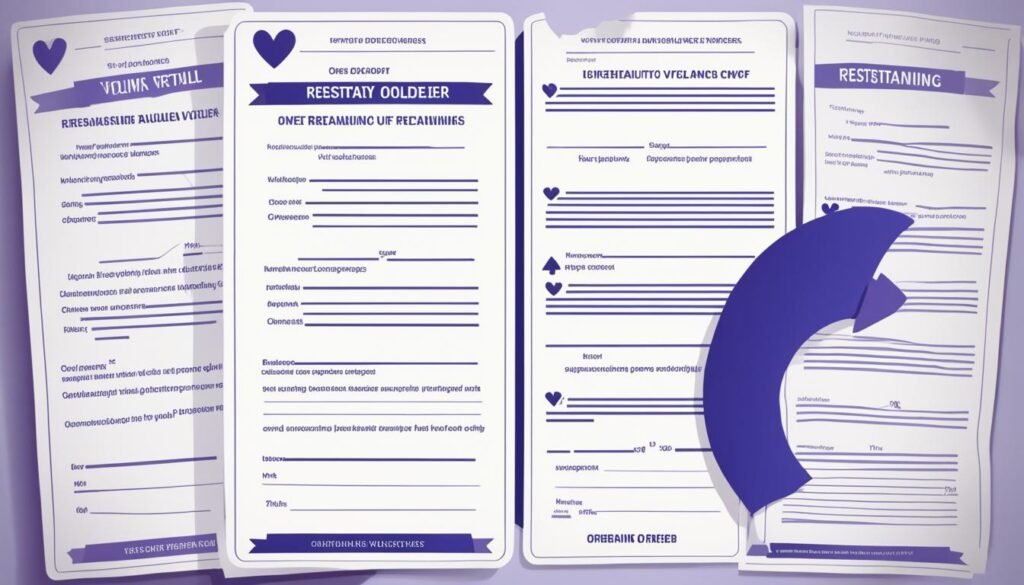Did you know that in Illinois alone, there are1 four types of protection orders? These orders help keep people safe from domestic violence, harassment, and threats with firearms. If you’re facing danger or want to stop future harm, it’s key to know your rights and options.
This guide will cover what restraining orders are, the different types, who can get them, and how to get one. It will also talk about what the order means and how it’s enforced. By the end, you’ll know how to protect yourself and your loved ones.
Key Takeaways
- Restraining orders are a legal tool that can provide critical protection for victims of domestic violence, abuse, and harassment.
- There are four main types of protection orders in Illinois: Order of Protection, Civil No Contact Order, Stalking No Contact Order, and Firearms Restraining Order.
- Domestic violence restraining orders in California can be filed against a broad range of individuals, including current or former spouses, dating partners, and family members.
- The burden of proof for obtaining a restraining order is a “preponderance of the evidence,” a lower standard than the “beyond a reasonable doubt” requirement in criminal cases.
- Seeking professional legal assistance can help ensure that the necessary evidence and legal requirements are met when petitioning for a restraining order.
What is a Restraining Order?
A restraining order, also known as a protective order, is a legal document from a court. It helps protect someone from physical, sexual, emotional, or psychological abuse, threats, stalking, or harassment2. The main goal is to give victims of abuse legal help and safety2.
Definition and Purpose
Restraining orders stop the person being restrained from contacting, approaching, or harming the protected person. They can also cover child custody, property, and gun issues2. Each state has its own rules for these orders, but they’re key for victims to stay safe and stop abuse2.
These orders can be against partners, family, or in-laws2. They cover emotional, physical, or online abuse2. Victims can get orders tailored to their specific needs3.

“Restraining orders are a crucial safeguard for victims of abuse, providing them with legal recourse and the means to protect their wellbeing.”
Types of Restraining Orders
The legal system has different types of restraining orders to protect people from harm. Each type is made for specific situations and relationships. These orders help victims feel safe and seek justice.
The Domestic Violence Restraining Order helps victims of abuse who are close to their abuser. This includes spouses, ex-spouses, or partners4. These orders can stop contact, give temporary home control, and require the abuser to get help.
Elder or Dependent Adult Abuse Restraining Orders protect seniors and vulnerable adults from abuse5. Civil Harassment Restraining Orders help those being stalked or threatened by someone they don’t know well, like a neighbor.
Employers can get Workplace Violence Restraining Orders to protect workers from threats at work5. These orders make the workplace safer for everyone.
All restraining orders aim to keep people safe and give them legal ways to feel secure again. It’s important for victims to know these options to start protecting themselves and seeking justice.

| Type of Restraining Order | Eligibility | Key Provisions |
|---|---|---|
| Domestic Violence Restraining Order | Victims with close relationship to abuser (spouse, former spouse, dating partner) | Prohibit contact, grant temporary residence possession, mandate treatment programs |
| Elder or Dependent Adult Abuse Restraining Order | Seniors and vulnerable adults | Protect from physical, financial, or emotional abuse |
| Civil Harassment Restraining Order | Individuals being harassed, stalked, or threatened by someone they don’t have a close relationship with | Cease harassment, stalking, or threats |
| Workplace Violence Restraining Order | Employers seeking to protect their employees | Safeguard employees from stalking, harassment, or threats at the workplace |
Domestic Violence and Restraining Orders
Eligibility and Coverage
Victims of domestic violence, intimate partner abuse, or family violence can get a restraining order for safety6. This order helps protect victims and their loved ones6. It can cover people in close relationships like spouses, ex-spouses, dating partners, or family7.
Restraining orders stop the abuser from contacting or being near the victim6. They can also cover child custody, support, visitation, and property issues6.
Domestic violence includes physical, sexual, emotional, economic, or psychological abuse7. To get a restraining order, the victim must prove the abuser has been violent or harassed more than once8. The court can give a temporary order right away, then hold a hearing in 15 days to decide on a permanent order8.
Victims can file for a restraining order in their home county, where the abuser lives, or where they last lived together6. They can get help from a domestic violence advocate and don’t need a lawyer or to pay fees6. Even those in non-romantic relationships, like roommates or siblings, can get a restraining order through the Magistrate Court6.
Remember, a Mutual Restraining Order might seem easy but it can be complex in domestic violence cases6. Victims should get legal advice to protect their safety and rights6.
Obtaining a Restraining Order
Process and Requirements
Getting a restraining order is key for those facing domestic violence. It starts with filing a petition that details the abuse and harassment9. The court might then give a temporary restraining order, which means the abuser must be served and may have to give up any guns1011.
At the next court hearing, both sides can share evidence and stories. If the judge thinks there’s enough proof, a final restraining order will be given, lasting up to a year11. This order can be renewed if needed to keep the victim safe.
- File a petition with the court, outlining the abuse and harassment experienced.
- Attend a court hearing, where both the victim and the abuser can present evidence and testimony.
- If the judge finds sufficient grounds, a final restraining order will be issued, typically lasting up to one year.
- The restraining order can be renewed if necessary to maintain the victim’s safety and protection.
Legal help is very important during this process. It makes going through the legal system easier and helps get the best outcome for the victim11.
Provisions and Enforcement
Restraining orders can protect victims of domestic violence in many ways. They can stop the abuser from contacting, harassing, or being near the victim, their home, work, or kids’ schools12. The order might also make the abuser leave a shared home and give up any guns or weapons12.
If someone breaks a restraining order, they could face big trouble. This trouble can include criminal charges, fines, or even jail time12. It’s the job of the police to make sure these orders are followed. Victims should tell the police right away if someone is breaking the order13.
- A Family Court order of protection can last up to two years or up to 5 years in serious cases12.
- A final order of protection from Criminal Court can last up to 8 years12.
- A permanent order of protection can be given by the Supreme Court during a divorce12.
Breaking an order of protection can lead to arrest and criminal contempt charges12. A temporary order usually lasts until the next court date12.
| Restraining Order Provisions | Description |
|---|---|
| No-Contact Orders | Stop the abuser from contacting the victim, directly or indirectly. |
| Stay-Away Orders | Make the abuser stay away from the victim’s home, work, or other places. |
| Firearm Restrictions | Stop the abuser from having or buying guns. |
Experts have different views on how well restraining orders work. Some think they can help prevent more violence, while others are not so sure14. They do offer legal protection13, but studies show they might not always keep someone safe from future violence14.
“In cases of domestic violence, victims may need to show they are in real fear of being hurt soon. In some places, just showing the abuser is stalking or harassing is enough.”13
Conclusion
Domestic violence is a tough issue, but restraining orders can be a big help15. They give victims important legal15 support. Yet, services aimed at keeping families together might not fix the deep issues or make things better for the kids in the long run16. It’s key to tailor help to each family’s unique needs, focusing on16 health, safety, and well-being.
Learning about restraining orders can help victims take a big step towards feeling safe again15. There are also groups like the Super Attorneys Of Irvine (949-996-9546) that offer free15 legal help, counseling, and other15 Domestic Violence Resources. These can make it easier to get through the legal process and find the support you need.
You’re not alone, and there are resources and people ready to help you stay safe15. Programs for Safety Planning and Victim Advocacy offer the support and guidance needed to face domestic violence. They help you start on the journey to healing and empowerment15.
FAQ
What is a restraining order?
What are the different types of restraining orders?
Who is eligible for a domestic violence restraining order?
How do I obtain a restraining order?
What are the provisions and enforcement of a restraining order?
Source Links
- https://illinoisattorneygeneral.gov/Safer-Communities/Violence-Prevention-and-Community-Safety/Orders-of-Protection/
- https://selfhelp.courts.ca.gov/DV-restraining-order
- https://victimconnect.org/learn/protection-orders/
- https://vscc.virginia.gov/protective-orders-virginia-guide-victims-english.pdf
- https://www.hesterlawgroup.com/blog/2023/february/4-types-of-protective-orders/
- https://sclegal.org/brochures/type-of-domestic-violence-protection/
- https://www.occourts.org/self-help/restraining-orders
- https://sc.edu/study/colleges_schools/law/academics/experiential_learning/clinics/domestic_violence/_resources/ro_plaintiff.php
- https://www.new-york-lawyers.org/orders-of-protection.html
- https://ujslawhelp.sd.gov/protectionorders.aspx
- https://thedoylelawoffices.com/blog/how-to-file-a-restraining-order-in-nc/
- https://opdv.ny.gov/orders-protection
- https://legal-info.lawyers.com/criminal/criminal-law-basics/restraining-orders.html
- https://en.wikipedia.org/wiki/Restraining_order
- https://tibbslaw.com/2023/07/20/how-restraining-orders-serve-as-protective-measures/
- https://nap.nationalacademies.org/read/5285/chapter/11

